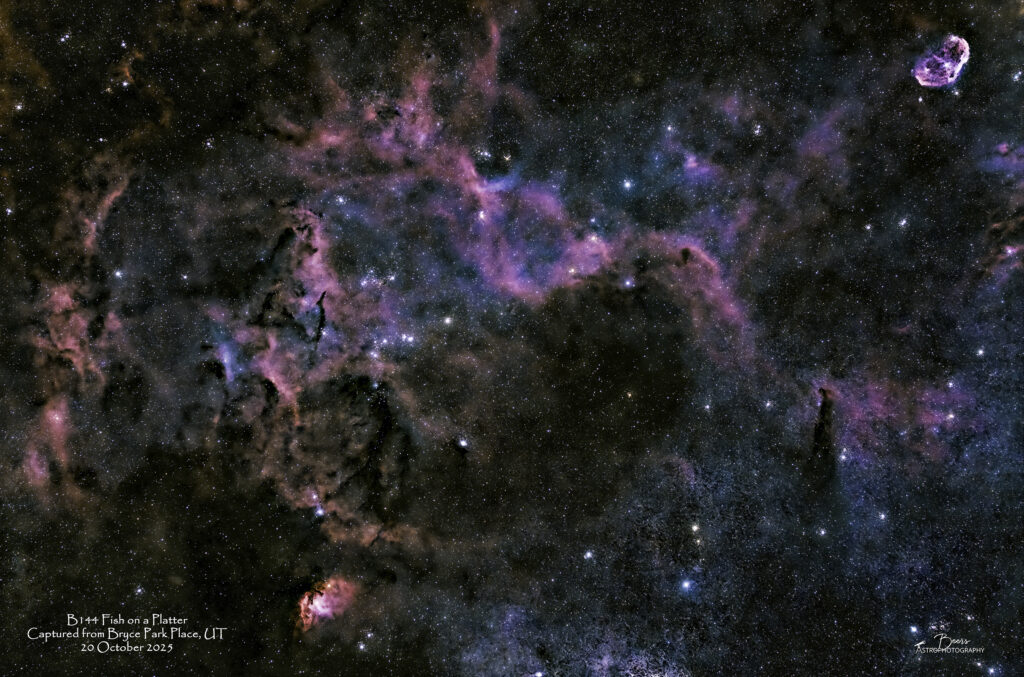
Fun facts
There is some degree of confusion over the identity of the Fish on a Platter Nebula. Most sources agree that it represents the dark cloud Barnard 144, but it is occasionally listed as Barnard 143, which forms part of the ‘E’ Nebula in Aquila. Neither structure is immediately reminiscent of a fish, on a platter or otherwise. Perhaps we are intended to see this region as the head of a fish pointing northward, with the orange star Eta Cygni as its eye and the nebulous patch to the east (the Tulip Nebula, Sh2-101) as its open mouth, though this is hardly a definitive interpretation
- Other Catalog Designations: Barnard 144
- Subtype: Dark Nebula
- Distance from Earth: 6000 light years
- Apparent Size: 6° x 3°
- Constellation: Cygnus
{From: https://www.glyphweb.com/esky/nebulae/fishonaplatter.html }
BeersAstrophotography editorial comment: Since there’s quite a dearth of information about this object and very few examples of astrophotographers or astronomers who actually do see a “fish on a platter” in their images or during their viewing, I’ll make a few editorial comments (in keeping with the section’s title – some may be fun, but not necessarily all are facts!).
First, a statement of the obvious…there’s a lot going on here! This is a dark nebula buried in a very dense star field (Cygnus Star Cloud). If I cheat and look at the star field in the raw image stack I can almost see a nose of a fish near the center of the image pointing to the northeast, with its body laying (on a platter of stars?) in an arch down to the southwest and its tail swooping up to the northwest. A good friend of mine, after viewing the image stated seeing the fish in the blue nebulosity near the center. With that suggestion in mind, I too, can see that blue nebulosity fish but can’t unsee my dark nebulosity fish (see the primacy effect description in NGC7822’s fun facts). Perhaps this object should be renamed “Two Fish on a Platter” for the blue nebulosity fish laying on top of the dark nebulosity fish?? Okay, maybe I’m getting a little carried away… All that photographic interpretation aside, it may take a lot of staring and perhaps a drink or two, to begin to really see a fish or two!
One comment closer to “fact”…it is interesting to note the SH2-101 Tulip Nebula in the bottom of the SW quadrant and the NGC6888 Crescent Nebula in the top NE corner of the image. I have imaged both of those DSOs with my bigger telescopes (Big Zeus and Big Bertha, respectively) and filled the frame with them! Using the Southern Cross and the 0.7x focal length reducer they look like little blob afterthoughts. Illustrating the old adage “space is big”!
Capture & Processing Notes
B144 was a new target that I discovered in Telescopius while I was doing my planning for our September dark skies trip. I was excited to have an opportunity to image a new dark nebula under dark skies. But, the mosquitoes chased us out of New Mexico’s Kiowa National Grasslands in September before I had the chance. So, I transitioned B144 to my October target list and prioritized it near the top of the list, as its visibility was waning as the year moves on (best visibility in July).
I captured this as my first target during our second night at Bryce Park Place. It had been sunny and clear all day so I was able to set up and begin imaging as soon as it was dark enough for the polar alignment. B144 was already on the west side of the meridian when I started the sequence at 19:44MDT and everything went well with the initial start-up, except a “Large RA/Dec delta error” message from PHD2, which I attributed to the near vertical telescope position very near the meridian. (It turns out that when I did the polar alignment on the third night, I discovered the mount was out of alignment in declination – which is probably the true cause of that error (and the rough autoguiding throughout the night)).
I imaged B144 from 19:52MDT until 21Oct2025, 01:35MDT when it set below 20° collecting 63x5min subframes, then switched to M31 Andromeda for the rest of the night.
Sequence Plan: Gain 158, Offset 30, Temp 0°C; 63x5min. Captured 20Oct2025, 19:52MDT – 21Oct2025, 01:35MDT. Total time: 315 minutes; 5:15hr
Processing summary: Captured in SGP, stacked in APP (Adaptive Airy), star removal with Starnet++, processing with LR/PS (using my new adaptation of Bill Banshan’s star removal process).
Equipment
Equipment: All equipment controlled by HP Probook (DSO-CTRL1) running Sequence Generator Pro v4.4.1.1441.
- Imaging (ASI2400-SC with 0.7x Reducer): ZWO ASI2400MC imaging camera; (Southern Cross) Askar FRA600 108mm f/5.6 Quintuplet Petzval Flat-Field Astrograph with Askar 0.7x Reducer for Askar FRA600 108mm Astrograph
- Mount: Rainbow Astro RST-135E (controlled by iHubo ASCOM driver)
- Polar alignment: QHYCCD camera (controlled by Polemaster for polar alignment)
- Autoguiding: Orion 60mm Multi-Use Guide Scope with Orion StarShoot AutoGuider Pro Mono Astrophotography Camera (controlled by PHD2)
- Auto Focuser: ZWO EAF Electronic Automatic Focuser – Standard (New 5V Version) (EAF-5V-STD)
Summary
Captured: 20Oct2025, 19:52MDT – 21Oct2025, 01:35MDT. Total time: 315 minutes; 5:15hr
Shooting location: Bryce Park Place, Cannonville, Utah
Equipment: Southern Cross with 0.7x Reducer
Processing summary: Captured in SGP, stacked in APP (Adaptive Airy), star removal with Starnet++, processing with LR/PS (using my new adaptation of Bill Banshan’s star removal process).
